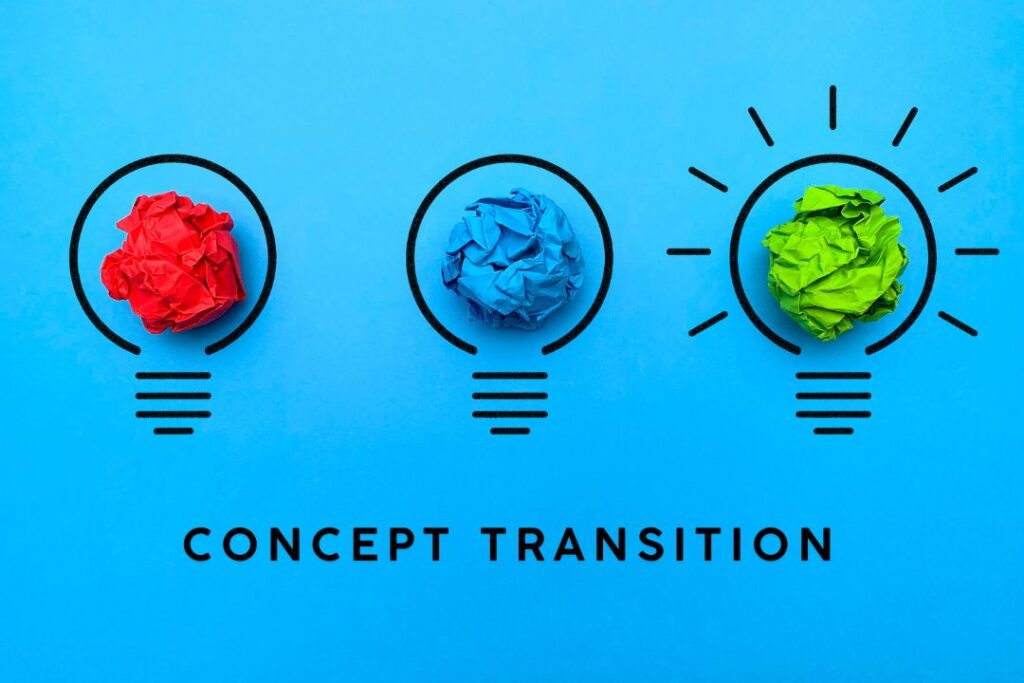Mastering Concept Transition: Practical Steps and Psychological Insights for Smooth Change

Published on: August 31, 2025
Concept transition in simpler form is like moving from one stepping stone to another in a river. Imagine you’re standing on one stone (an idea, stage, or situation), and you want to reach the next stone. Transition is the process of crossing over smoothly so you don’t fall in the water. It’s the change or shift that helps you go from where you are now to where you want to be next.
For example, when a caterpillar changes into a butterfly, that transformation journey is a transition. Or when someone moves from being a student to starting a job, that’s a transition too. It’s about change and moving forward, linking what was before with what comes next.
In simple terms, concept transition means changing from one thing to another in a way that connects them smoothly and lets you keep going without stopping or confusion.
The Role of Emotional Intelligence in Concept Transition
One fascinating and crucial aspect of successfully navigating concept transitions is the role of emotional intelligence (EI). Emotional intelligence—the ability to recognize, understand, and manage one’s own emotions, as well as empathize with others’ feelings—significantly impacts how individuals cope with change.
During transitions, heightened emotions such as anxiety, frustration, or excitement are common. People with high emotional intelligence can better regulate these feelings, communicate their needs clearly, and maintain productive relationships, which eases the psychological strain of change. Moreover, EI encourages openness to new ideas and adaptability, both essential for embracing new beginnings. Leaders and organizations that foster emotional intelligence create environments where transitions are seen as opportunities rather than obstacles, boosting overall resilience.
Incorporating emotional intelligence development into transition plans can lead to smoother adjustments, reduced conflict, and enhanced well-being, making it a powerful tool in managing both personal and professional transformations.
This highlights why emotional awareness and empathy are not just soft skills but critical elements in mastering successful concept transitions.
Practical steps to navigate a personal transition
Practical steps to navigate a personal transition provide a clear and simple plan for managing life changes. They help people identify what they want, assess their current situation, and break the process into small, doable actions. This approach encourages staying flexible, seeking support, and preparing for challenges. By following these steps, individuals can handle change with less stress and more confidence, turning transitions into times of growth and new opportunities.

- Embrace Reality and Open Your Mind: Start by acknowledging the change rather than fighting it. Accepting that change is part of life helps lower stress and opens the door to new possibilities. Think of change as a chance to evolve and learn, not something to fear or avoid.
- Look Within and Understand Yourself: Take time to pause and reflect on your current emotions, strengths, and areas where support is needed. Knowing yourself better sets a solid foundation for setting clear intentions during your transition.
- Set Clear Targets and Make a Roadmap: Define specific goals for where you want to go next. Break these goals into easy steps and create a flexible plan that guides your progress, allowing room for adjustments along the way.
- Boost Your Confidence by Celebrating Every Win: Even small accomplishments during the transition are worth recognizing. This positive reinforcement encourages courage and a belief in your ability to handle whatever comes next.
- Reach Out and Build Connections: Find friends, mentors, or groups who can listen and support you through the change. Sharing experiences with others helps reduce feelings of loneliness and provides motivation.
- Prepare for Ups and Downs with Coping Tools: Anticipate moments of difficulty and equip yourself with strategies like mindfulness, relaxation techniques, or creative outlets to stay grounded during stressful times.
- Keep Track and Stay Adaptable: Regularly check in on your progress and remain open to changing your approach if needed. Flexibility helps you maintain momentum and stay aligned with your core values as you grow.
This personalized approach encourages resilience and self-awareness, helping anyone move through life’s changes with strength and clarity.
Iconic Personal Reboots: Success Stories
- Jeff Bezos shifted from a high-powered finance job to founding Amazon. He saw the internet’s potential early, started small with an online bookstore, and adapted relentlessly to grow his company into a global leader. His journey shows the importance of vision, planning, and flexibility when navigating a big life change.
- Vera Wang transitioned from aspiring Olympic figure skater to renowned fashion designer, ultimately becoming a celebrated icon in the bridal and couture world. After working in fashion publishing, she followed her passion to design, starting her new path at 40. Her story highlights how merging past experiences with new goals can create powerful success during personal transitions.
- Julia Child transformed from intelligence work to becoming a culinary legend later in life. Her determination to learn and embrace a completely different path teaches that dedication and courage are key to thriving through change.
- Martha Stewart shifted from Wall Street to building an empire around home and lifestyle. By focusing on her interests, gaining expertise step-by-step, and leveraging media connections, she crafted a brand that resonates worldwide, illustrating how clear goals and strong support networks help in transition.
- J.K. Rowling moved from struggling single mother to world-famous author. Her story is about perseverance, believing in oneself, and growing through setbacks, showing that persistence and passion can powerfully guide personal change.
These examples reflect how vision, self-awareness, patience, learning, and support are practical steps that anyone can apply to walk confidently through their own personal transformations.
Navigating Change: Common Roadblocks and How to Overcome Them
People face several common challenges when undergoing concept or personal transitions, especially in careers or life stages. Here’s an overview of these problems and ways to avoid them:
- Fear-Driven Decisions: Many people undertake transitions driven by fears such as missing out, dissatisfaction, or financial insecurity. This can lead to impulsive choices that don’t align with true desires. To avoid this, focus on moving toward what inspires and excites rather than merely escaping discomfort.
- Clinging to Comfort Zones: Leaving familiar roles and routines is tough because they shape identity. This can cause insecurity and doubt about new abilities. Overcome this by recognizing transferable skills and seeking learning opportunities to build confidence in new areas.
- Narrow Focus on Titles or Roles: Getting fixated on specific job titles limits possibilities and may overlook fulfilling alternatives. Instead, define your strengths and interests broadly to explore diverse and meaningful options.
- Trying to Make One Big Decision at Once: Facing a huge life change all at once can be overwhelming, creating paralysis. Break transitions into smaller steps and build gradual progress toward the bigger goal.
- Lack of Experience or Skills: Feeling unqualified for a new role is common. Engage in reskilling or side projects to build relevant experience while highlighting transferable strengths.
- Financial Concerns: Worries about income loss during transition can stall progress. Creating a financial plan and considering temporary adjustments can ease this burden.
- Self-Doubt and Anxiety: Doubting personal ability or fearing failure is natural but can be debilitating. Positive self-affirmations and support networks help boost confidence and resilience.
- Burnout and Stress: Managing change alongside existing pressures can lead to overwhelm. Prioritize self-care, set realistic goals, and seek professional guidance if needed.
By recognizing these challenges early and applying strategies like focusing on passions, planning carefully, building skills, and seeking support, individuals can navigate transitions more smoothly and successfully.
Bridges Transition Model
Here is a block diagram of the psychology behind the transition process, based on the Bridges Transition Model:

- Ending (Letting Go): This first phase involves releasing old habits, roles, or identities. It often brings feelings of loss, sadness, or resistance as a person detaches from what was familiar and comfortable.
- Neutral Zone (In-Between Phase): Sometimes called the “neutral zone,” this stage is where the old is gone but the new hasn’t fully taken shape yet. It can be confusing and unsettling, filled with uncertainty and doubt. This period serves as a vital opportunity to pause, gain insights, and realign attitudes and behaviors for effective progress.
- New Beginnings (Fresh Start): At this final phase, individuals embrace new roles and ways of thinking. Energy and motivation rise as people settle into their new reality with renewed purpose and commitment.
This model highlights that change is not just about external events but the internal psychological journey people undergo. Supporting individuals through these phases with patience and understanding makes transitions smoother and more successful.
This framework is inspired by William Bridges’ Transition Model and helps clarify the emotional and cognitive process people typically experience during change.
Concept transition implementation
Concept transition can be implemented effectively in various contexts such as organizations, education systems, and personal development by applying structured approaches like the Bridges Transition Model.
Where to Implement:
- In Organizations: During restructuring, leadership changes, technology upgrades, or process overhauls, organizations face significant change. Concept transition helps employees let go of old ways, navigate uncertainty, and embrace new roles or systems.
- In Education: When students move from one educational stage to another or adopt new learning methods, concept transition supports their adaptation emotionally and mentally.
- In Personal Life: Individuals experiencing life changes—career shifts, relocations, or lifestyle changes—can use concept transition to navigate the emotional and psychological challenges involved.
How to Implement:
- Identify and Acknowledge Endings: Recognize and openly communicate the endings or changes occurring, allowing for clear understanding and emotional closure. This helps individuals understand their feelings and reduces resistance.
- Support the ‘Neutral Zone’: Nurture the ‘Neutral Zone’ by offering support, skill-building opportunities, and a safe environment for individuals to adjust and find their footing. Encourage creativity and feedback while acknowledging uncertainty and confusion.
- Facilitate New Beginnings: Clarify new roles, goals, and expectations. Reinforce commitment through positive reinforcement, training, and celebrating milestones.
Effective implementation requires transparent communication, emotional support, and continuous engagement, enabling smoother adoption of change and stronger alignment with new directions.
This practical approach turns the psychological process of transition into actionable steps that promote resilience and growth across organizational and personal spheres.
Concept Transition and Habits
Concept transition and habits are closely connected because the habits people develop or change significantly influence how smoothly they navigate through transitions. When experiencing a concept transition—such as moving into a new phase in life or adopting a new mindset—establishing supportive habits helps provide structure and stability amidst uncertainty.
During transitions, people often face unpredictability and emotional ups and downs. Consistent habits, such as daily reflection, setting small achievable goals, or maintaining physical health routines, create anchors that promote mental clarity and progress. For example, building habits that focus on small, intentional actions daily can help accumulate meaningful change over time even when the overall direction feels unclear.
However, not all habits aid transitions. Identifying and replacing negative or unproductive behaviors—like procrastination or avoidance—with positive routines is vital. Also, understanding one’s basic psychological and emotional needs during the transition allows for tailoring habits that create a sense of safety, progress, and healing.
In short, habits are the practical tools that support managing change by providing:
- Structure in uncertain times
- A sense of control and achievement
- Emotional regulation and resilience
- Steady progress toward new goals
Fostering the right habits during concept transitions transforms a potentially chaotic experience into an organized and manageable journey of growth and adaptation.
This insight highlights why designing mindful habits is a key strategy for anyone navigating important life or mindset shifts.
Conclusion
Concept transition is a vital process for navigating change smoothly, whether in personal life, education, or organizations. By understanding that transition is not just about external changes but also the internal psychological journey, individuals and leaders can better support themselves and others through endings, uncertainty, and new beginnings. Practical steps such as embracing reality, self-reflection, setting clear goals, building confidence, seeking support, and staying adaptable help turn potentially stressful changes into opportunities for growth. Establishing positive habits during transitions adds structure and emotional resilience, making the path clearer and more manageable.
Drawing inspiration from the journeys of iconic figures and the proven frameworks like William Bridges’ Transition Model, anyone can master the art of transition by honoring the emotional phases and equipping themselves with mindful strategies. This well-rounded approach transforms transitions into enriching experiences that foster resilience, enhance clarity, and ignite renewed motivation.


